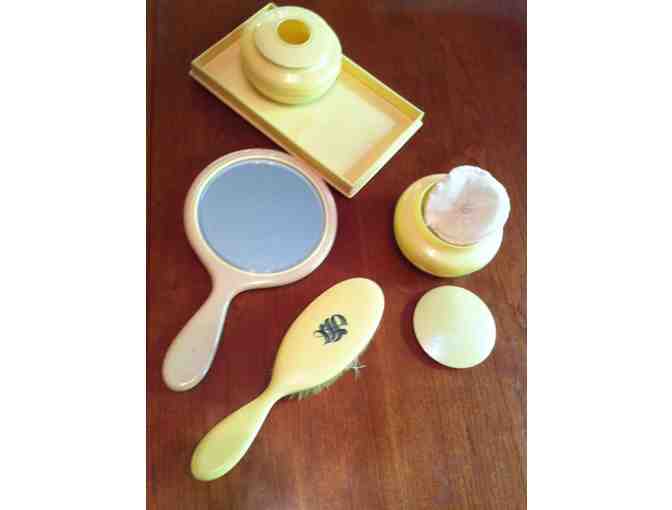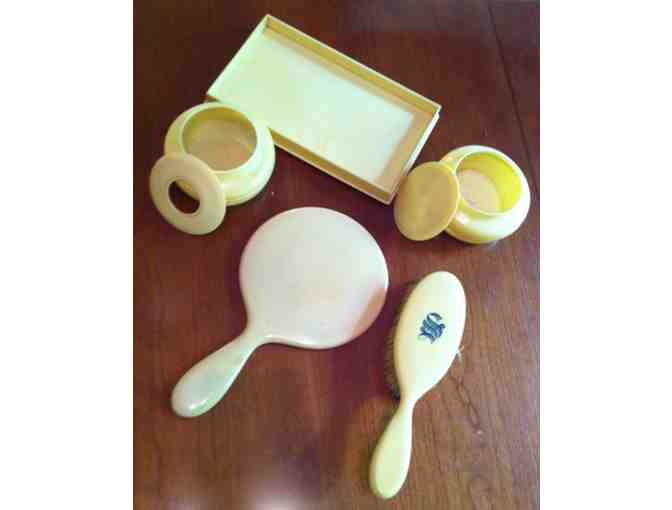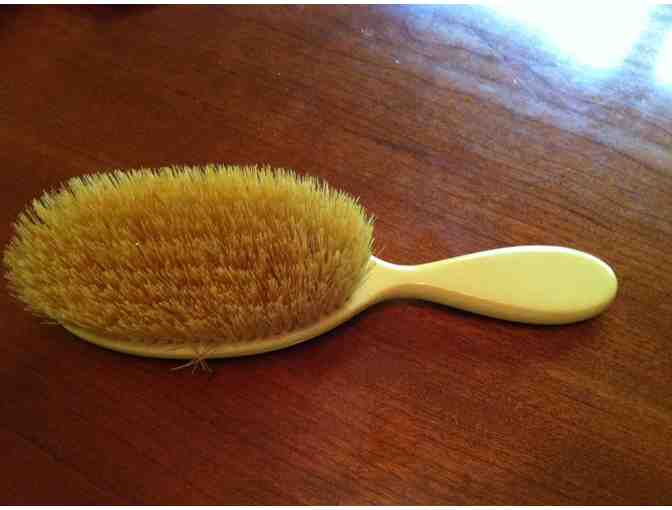Antiques
Early 1900s Celluloid "French Ivory" Dresser Set
- Item Number
- 112
- Estimated Value
- 75 USD
- Sold
- 30 USD to fluffyhiphop
- Number of Bids
- 2 - Bid History
Item Description
Are you a fan of Downton Abbey? Add atmosphere straight from Edwardian England to your boudoir with this charming dresser set. This beautiful celluloid dresser set contains a round hair receiver with lid, a round powder container with original powder puff and lid, a natural bristle hairbrush with an 'S' monogram, a round hand mirror, and an oblong tray all in very good condition. The warm pale yellow color that celluloid is known for is even throughout the pieces.
For those who don't know, Celluloid is actually its own class of compounds, created from nitrocellulose and camphor. The very first celluloid as a bulk material for forming objects was created in 1855, by Alexander Parkes in Birmingham, England. This new 'Parkesine' earned Parkes a bronze medal at the Great Exhibition in London in 1862, birthing the plastics industry.
Celluloid was eventually exported to America in the form of billiard balls, manufactured by John Wesley Hyatt and his Albany Billiard Ball Company. His brother, Isaiah Hyatt, saw the use of camphor in the product, and dubbed the material "celluloid" in 1872. From there, the material exploded throughout the United States - almost literally. Movie and photography films made in the 50's were made of celluloid, which explodes when exposed to temperatures over 150°C in front of a movie projector beam.
Celluloid had other uses as well, for creating less expensive jewelry, jewelry boxes or other items that previously would have been made from ivory. It saw use in dressing table sets, dolls, picture frames, charms, hat pins, buttons, buckles, stringed instrument parts, accordions, fountain pens, cutlery handles and kitchen items. Celluloid's popularity was overtaken by Bakelite, the first completely synthetic plastic, due to Celluloid's flammability and the difficulty and expense of producing it.
Item Special Note
Fun Facts:
-Celluloid is considered the first thermoplastic.
-Celluloid was often referred to as "French Ivory" and some was even marked by this name. It has nothing to do with the ivory harvested from animals.
-Celluloid was first known as Xylonite, and before that, Parkesine.
-Today, celluloid is used in table tennis balls, musical instruments and some guitar picks.
-Celluloid appears multiple times throughout the show "Downton Abbey" in the background set or in characters jewellery.
Caring for Celluloid: Celluloid is incredibly flammable, so it must be kept away from heat sources. In addition, it can emit fumes that can damage metal, so it's best kept in an area where in can breathe. Celluloid pieces should not get wet, especially mirrors, jewellery with stones, and any piece that has already begun to deteriorate. If you must test whether something is celluloid, it will emit that scent of camphor under hot water. Over time, celluloid can chip, crack, or crumble, and while specific causes for this are unknown, it can spread from one piece to another. Celluloid, despite it's high flammability and fume emission, is perfectly safe to have around the house under safe conditions.
This item will be hand-delivered within 1 hour of East Haddam or mailed outside that range.
Donated By:
Connecticut League of History Organizations stores data...
Your support matters, so Connecticut League of History Organizations would like to use your information to keep in touch about things that may matter to you. If you choose to hear from Connecticut League of History Organizations, we may contact you in the future about our ongoing efforts.
Your privacy is important to us, so Connecticut League of History Organizations will keep your personal data secure and Connecticut League of History Organizations will not use it for marketing communications which you have not agreed to receive. At any time, you may withdraw consent by emailing Privacy@frontstream.com or by contacting our Privacy Officer. Please see our Privacy Policy found here PrivacyPolicy.



